Turkey
We travel light: a rucksack for everyone plus camera equipment. The destination: Turkey and Iraqi Kurdistan. We will be traveling by plane, bus and rental car. Izmir, Antalya, Side – yes, we’re skipping the entire Mediterranean coast. We want to go where the tourists don’t dare to go. Even the Turks wave their hands dismissively when we talk about our travel plans: “What do you want in eastern Anatolia? There’s nothing there.” And that is exactly our goal: to travel through the whole of Turkey and the Black Sea coast instead of the tourist strongholds in the south. We want to get involved with a country that is incredibly large and rich in culture, and which is the subject of controversial political debate in Germany. We want to find out what Turkey is really like, away from the clichés of kebab stalls and German reporting.

Where else should our trip begin if not in Istanbul, this megacity on the Bosporus? We join the throngs of weekend tourists and visitors to the Turkish capital. Istanbul, we quickly learn, is a city in constant flux, a city between worlds, a city that is everything and nothing. The side streets are full of Turkish teahouses, the financial district is as boring as anywhere. The people are modern and forward-looking, while at the same time we meet the reactionary and deeply religious Turks. We move between the continents of Europe and Asia, between the Orient and the Occident. Between the “actually-not-so-far-away” and a seemingly oriental distance. The Hagia Sophia, which has been converted back into a mosque. At the same time, the lowered gaze and the quiet voice when it comes to politics and religious fervor. We see headscarves, cheap trinkets and tradition. At the same time, we stumble across a self-confident youth, women who proudly stand by their femininity against all conservatism, and enlightened foresight. All of this swirls together in Istanbul to form a rhythmic pulse, a beat that directs the life of the city.


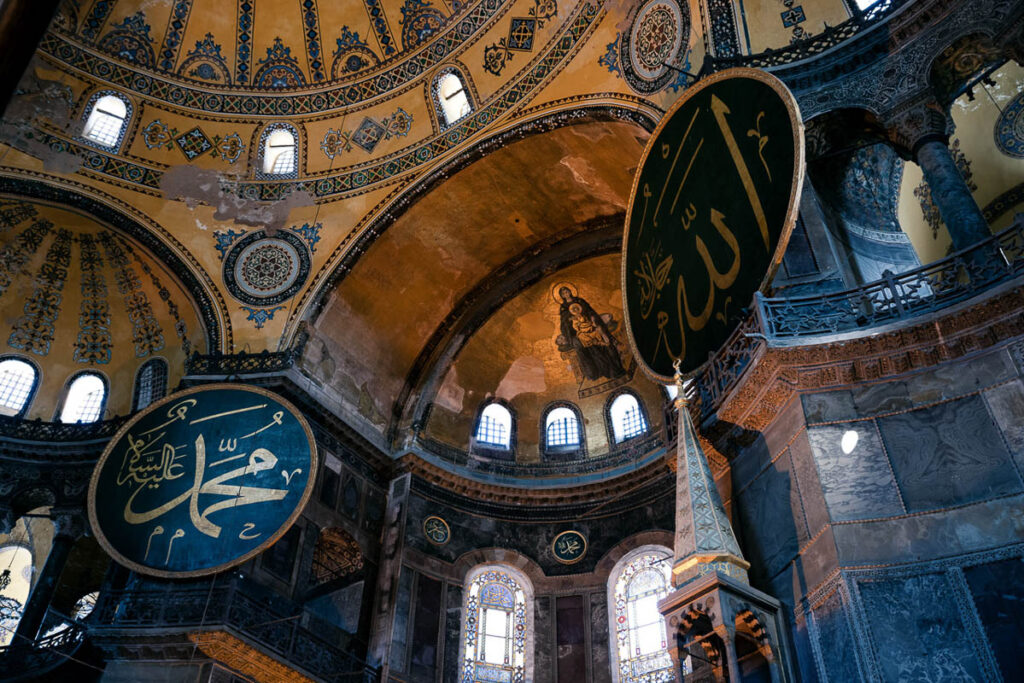

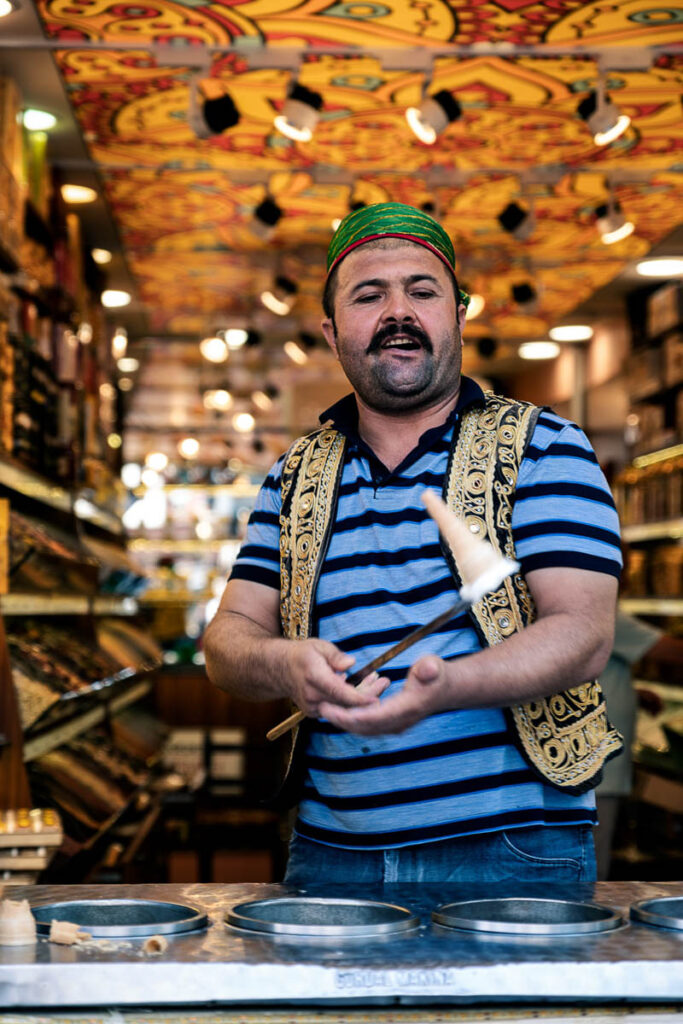


The night bus takes us to Ephesus, not too far from the vacation city of Izmir. We have breakfast at the bus station, tired and sleepy, stow our rucksacks there and set off on foot to the open-air museum, which is around 3 kilometers away. A narrow path leads us through orange and lemon groves, along walls overgrown with herbs and apple trees. Even now, early in the morning, it is well over thirty degrees. Not a cloud in the sky.
The theater of Ephesus offers a view of a vast marshland. In ancient times, the sea was right here. We sit down on the stone steps and imagine the dramas and competitions that were held here by starlight and torchlight against a breathtaking backdrop. Everything around us is incredible architecture: the Celsus Library or the Agora lying in ruins. The columns of Ephesus have survived almost two thousand years of human history. People crumble to dust, stone remains for eternity.





Another bus ride, this time in the afternoon, towards Denizli. We have rented a small, unimpressive room in the city center. In the evening we have Pide with fresh vegetables and homemade spreads. The next morning, we take the public bus to Hierapolis. The Greek settlement was located at the hot springs of Pamukkale and was an important trading town. The Odeon bears witness to the former size and importance of this settlement. The old city gate, the former paved main street, ruins upon ruins. We feel like time travelers, see the slaves toiling by the wayside, the aristocrats standing in the shade of the cypress trees, the markets filled with goods from the Mediterranean.
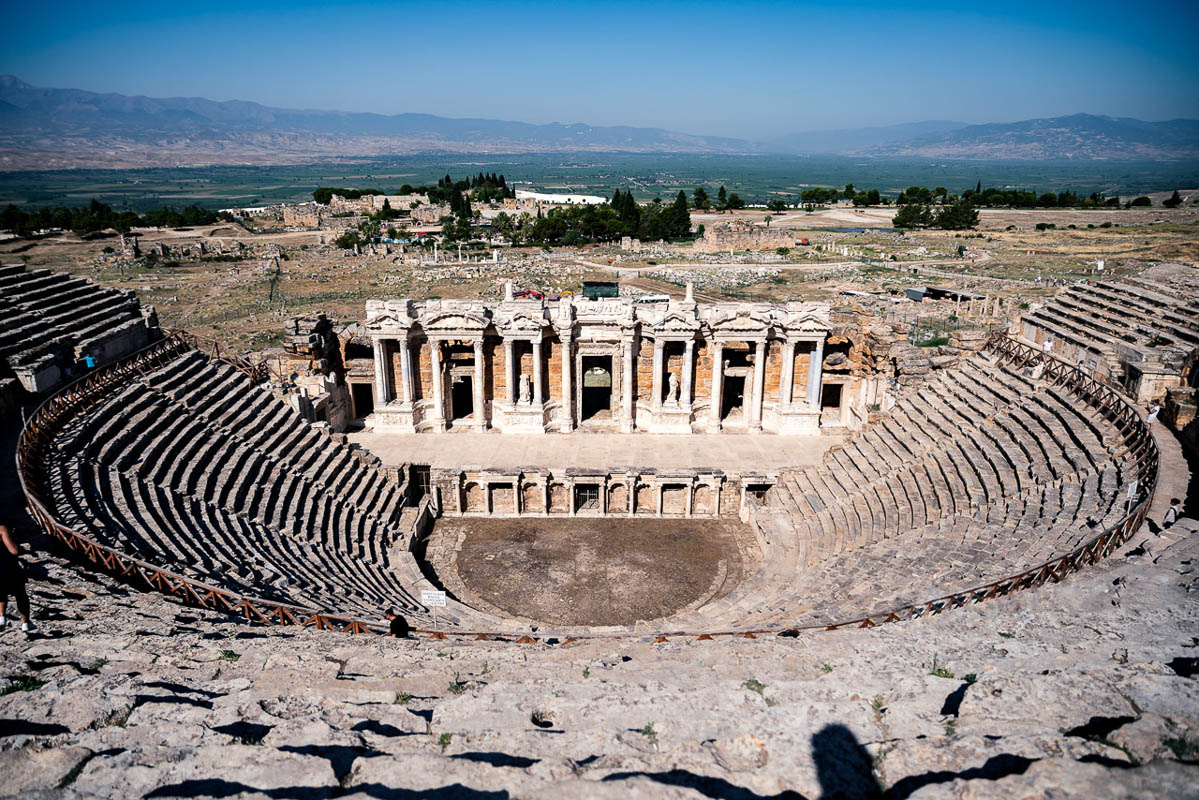
From the plateau on which Hierapolis lies, a wide path leads down through the water-filled limestone terraces of Pamukkale to the village that gives it its name. It is mainly Antalya vacationers that we meet here. Women in bikinis and with skin glistening with suntan lotion lie in the natural pools. Big-bellied men with sunburnt shoulders strut through the white limestone landscape on thin legs. Children scream and play tag. Warning signs everywhere point out what is forbidden in order to preserve this unique landscape. The signs are disregarded, the prohibitions ignored. Security forces admonish, but it’s all useless. We would love to have this place to ourselves: the Odeon of Hierapolis, the warm thermal springs with a fantastic view. Too many people congregate here in a small space.



Shortly before midnight – we have spent nearly eight hours on the back seat of an overbooked bus in temperatures of almost forty degrees – the bus driver lets us off at the main road just before Nevşehir. When we had bought tickets to Göreme, we hadn’t been told that the bus didn’t actually stop there. Now the driver and, inevitably, all the passengers had taken a detour just to get us closer to our destination. We encounter the friendliness and extraordinary helpfulness of the Turks everywhere in the country. A cab takes us safely from the highway to our hotel.
The next morning – refreshed with breakfast – we stroll through the town. Travel agencies, restaurants, quad bike rentals and tour operators. But Göreme is no ordinary town: it has been built in the middle of phallic-looking mountains and hills. Many of the houses are even carved into the stone, and caves and entire halls can be discovered everywhere forming underground cities. Cappadocia, as this natural landscape is called, immediately casts a spell over us. We leave the town on foot along lonely paths and enter a magical world. The land here is rugged, criss-crossed by valleys and sharp ridges. Kafkaesque rock formations that look like ritual sites in the blue light of the evening. We lose ourselves in the cave systems and hike through narrow gorges. In the distance, we hear the engines of off-road vehicles and ATVs.
We let the sun go down on a rocky plateau overlooking this lunar landscape. The twilight is only short. In complete darkness – guided by the stars – we find our way back to Göreme.






Before the sun rises the next day, we are woken by a strange hissing sound. First one, then more. We sleepily step outside the door: with the first rays of sunshine, an armada of hot air balloons is about to rise into the sky. There are more and more of them every minute – the sky is soon so full that the balloons keep gently bumping into each other. The brighter it gets, the more onlookers join us. The colorful hustle and bustle in the air increasingly loses its magic. The first balloons are already sinking to the ground and the spectacle ends just as quickly as it began.



The intercity bus spits us out again. This time it throws us into the middle of Ankara, a city of almost six million residents. The sun is just rising and, exhausted, we head for the first hotel we see. We can already move into a room for half the price.
At lunchtime, we plunge into the hustle and bustle. While Istanbul was a lively, multicultural and exciting megacity, Ankara is the more down-to-earth and sensible sister. The pedestrian zone is almost boring, even though it is incredibly crowded. We make our way to Anıtkabir, Atatürk’s mausoleum. Soldiers in parade uniforms follow the same route, their mines are petrified faces. The mausoleum itself is a gigantic square with a funerary monument, museum and exhibition. From the side fortifications, we have a colossal view over the city. Unfortunately, there is not much to see. Lots of residential buildings, sometimes a residential or office tower. A flat sea of roofs.
In the afternoon, when it is particularly hot, we stroll through the parched Gençlik Park. Past a huge mosque and street vendors, an alley leads us up to the citadel. Heavy fortress walls, street musicians and some peace and quiet from the crowds in the city center.




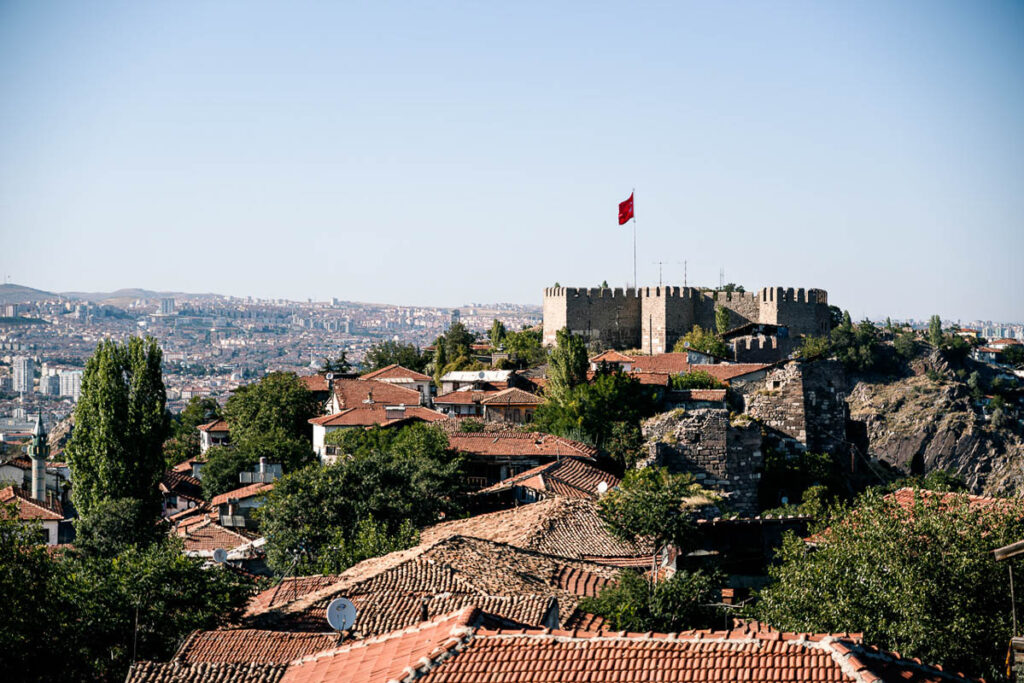
We reach the city of Diyarbakır by bus from Erbil. We were on the road for about twenty hours. It’s nighttime, luckily we’ve already booked a hotel. The next morning, we explore the city center of Diyarbakır – the Foreign Office warns against this city. It is predominantly Kurdish, and there are always riots and military deployment here. But on this bright blue August day, the city seems peaceful and tranquil.
We pick up our rental car at the airport and head west on straight, deserted highways through steppe landscapes. At some point, we gain altitude and the surrounding landscape becomes stonier, hillier and finally really mountainous. An ancient bridge spans a clear mountain river, numerous families enjoy its cool water: men and children play in the river, the wives sit on picnic blankets and guard the food on the barbecue. This is Anatolia, a conservative region. We, too, are repeatedly scrutinized with a critical eye.
We drive on and, after many hairpin bends, reach Nemrut Dağı. A shuttle takes us to the top at an altitude of over 2,000 meters. The air is clear, an orange band stretches across the horizon. The heads of ancient gods lie in ruins: A new religion was supposed to rise here, but storms, earthquakes and vandalism have decapitated the statues. So close to heaven, but powerless against the elements. The sun sinks, heaven and earth become one. Venus stands above us, night falls. We couldn’t get any closer to eternity.



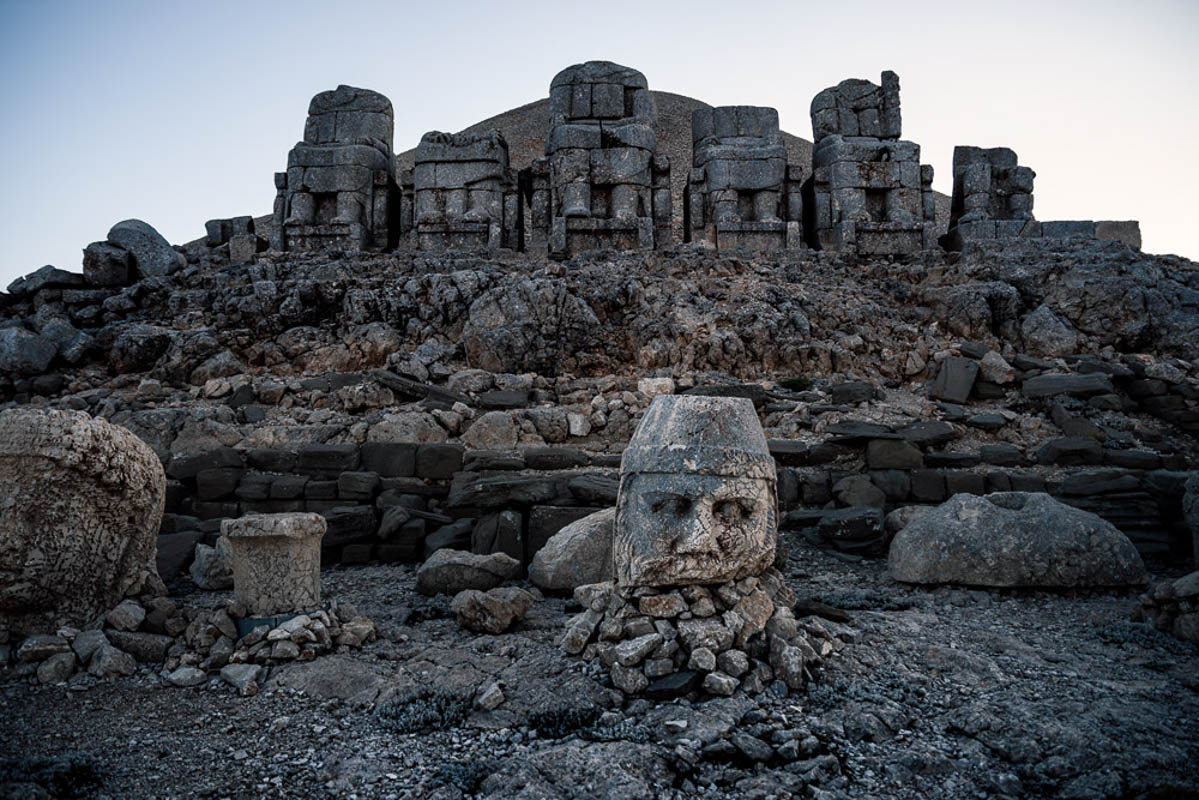



After another night in Diyarbakır, we drive to Lake Van in our rental car today. It’s a nice, quiet drive to the far east of the country. We stop for lunch in Tatvan, a town on the western shore of the lake that is not necessarily worth seeing. We follow the southern foothills of the lake to Van, where we explore the area. The Iranian border is only about 60 kilometers from here. It is also not far to Armenia and Syria. We don’t see any Western tourists, but all the more people from the surrounding countries. Also refugees and presumably illegal immigrants who want to continue on to Europe.
In the afternoon, we walk down to the lake beach. A large, unkempt park, laughing families, lots of hustle and bustle. Bridal couples take pictures in the golden late afternoon light, the booming bass of the wedding party in a nearby banquet hall drowns out every conversation. At sunset, we climb a rocky plateau on which the remains of an old castle lie. We have reached the easternmost point of our journey, having crossed the whole of Turkey once. From now on, we will head back west again.



Lake Van lies at an altitude of around 1,650 meters. Gentle mountains frame it, a cooling wind blows through our hair. An old boat takes us to the small island of Akdamar, where there is an old Armenian church and some ruins. This place was destroyed and looted during the Armenian genocide and is now a popular excursion destination among Turks. There is a lot that is not talked about here – the dark history of the Ottoman Empire, for example. Especially here in the far east of Anatolia.
On the way back to Diyarbakır, we stop for a toilet break at a small rest stop. Just as we are about to set off again, a heavily armored tracked vehicle pulls up next to us. Soldiers with large machine guns get out. Obviously they just want to take a break here, too. At the time of our journey, eastern Turkey is a risky area. The conflict with the Kurds has flared up, the attempted coup was not long ago, and the border region with Syria is a hot spot. There are military bombings, attacks and a high military presence. After leaving Diyarbakır the next day, we find out that tanks and soldiers invaded the city that very day to put down civil protests.



The whole of Turkey is out of town. All buses and connections are fully booked because of the Feast of Sacrifice. As we didn’t book anything in advance, this kept disrupting our travel plans. Instead of driving back to Istanbul with our rental car on the north coast, we have to return it and fly back to Ankara. Another rental car is waiting for us there.
We drive through a mountainous landscape with dense coniferous forests towards the Black Sea. The scenery is almost German low mountain range, but without the cuckoo clocks and cherry cake. In Samsun, we finally come across water – after almost three weeks of traveling through Turkey, this is our first contact with the sea. It is also the first rainy day with dense cloud cover.
Small villages are strung together like pearls on a necklace. Very few of them are worth seeing, there are hardly any beaches. If there are any, they are rocky and located in secluded bays. We let ourselves drift for a few days, eating freshly caught fish in beach restaurants and exploring all the little towns.
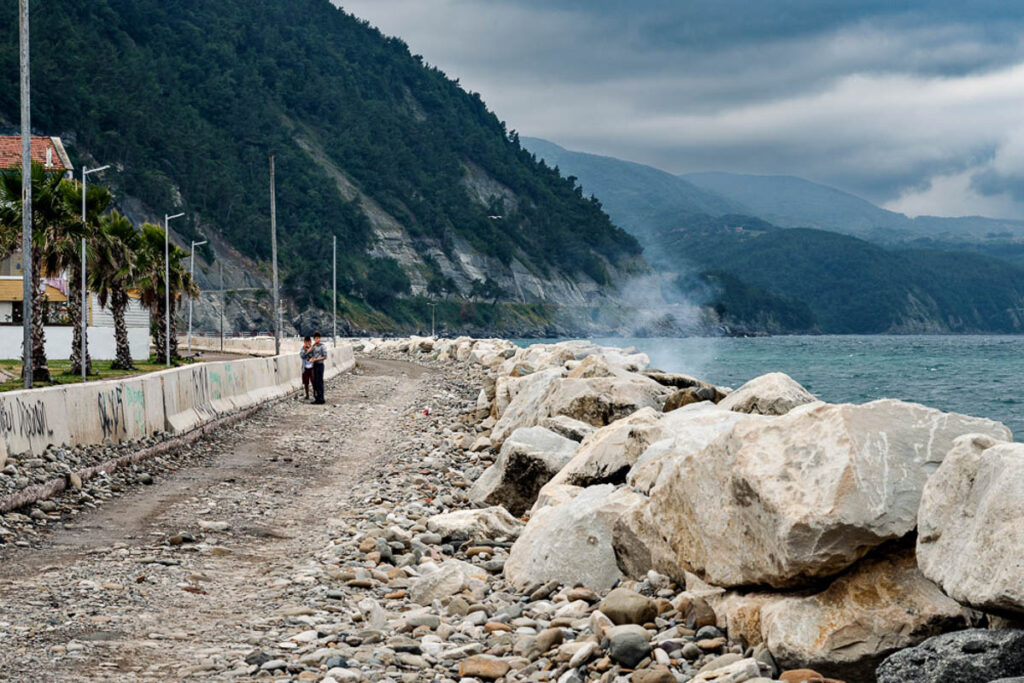





The small harbor town of Amasra is the last point on our itinerary. Narrow alleyways and many fish restaurants, boats rocking wearily on jetties in the ups and downs of the waves. Seagulls circle over the rooftops, the air tastes salty. A typical tourist town by the sea. What makes Amasra special and photogenic is the small island, which is connected to the mainland by a stone bridge. There are also two beech trees facing away from the sea with a sandy beach. The perfect end to our trip and time to reflect on the past three weeks.
As is the case with clichés: some were confirmed on our trip, others we were able to let go of. The Turks showed us their best and incredibly hospitable side. Again and again, we had wonderful conversations at completely unexpected times. It felt like all the Turks spoke German and had lived in Germany for some time. Language barriers were rare. The landscape could take our breath away, but sometimes an ochre-colored steppe desert stretched for hundreds of kilometers.



The temperatures have dropped, the sky is gray and cloudy. We spent the night in Bursa, a hilly industrial city, and dropped off our rental car at the airport in Istanbul.
Anyone traveling through a huge country like Turkey will encounter light and shade. Not everything will please, not everything will inspire. But it is the recurring highlights that made our road trip to Turkey one of our best vacations. We will never forget the fantastic rock formations of Cappadocia. Lake Van in the rugged mountains and the rough Black Sea coast, completely ignored by foreign tourists, were unique insights into this multifaceted country. The political turmoil continues to this day, even though the security situation has improved considerably in general and in the east of the country in particular. Turkey will see us again.
Info about our trip
It is a shame that tourism in Turkey is mostly focused on Istanbul and the well-known vacation resorts on the Mediterranean. The inland also has a lot to offer. But admittedly: The beaches on the Black Sea can’t compete with the beaches in the south, and there is a lack of tourist infrastructure. The east of the country is also probably only interesting for real history and culture fanatics. Our highlights of the trip were by far the mystical rocky landscape of Cappadocia and Mount Nemrut Dağı. Ephesus is also worth a day trip, Hierapolis less so due to the many tourists. What we really enjoyed on the Black Sea and in eastern Anatolia was the peace and quiet. We were the only tourists everywhere – Turks kept asking us with incomprehension why on earth we were not in Side or Antalya, but here at the rocky Lake Van.
The Turks are generally friendly and helpful without being pushy. Unfortunately, we also experienced a few minor scams and frauds. Wherever we went, someone always spoke German and so we had many nice conversations. Turkey has become much safer in recent years, so you can travel around the country without hesitation. The infrastructure is well-developed, the hotels are generally clean and the prices are still comparatively cheap – despite the enormous inflation of recent times. Two weeks are certainly enough for a short round trip, but three to four weeks are appropriate for a long tour of the whole country.
It is still possible to spend a cheap vacation in Turkey. Even if the all-inclusive offers have increased compared to the time before Corona and the enormous inflation, a beach vacation in Turkey is still one of the cheapest ways to get to the sun quickly. But the rest of the country in particular is also very easy to travel around on a budget. You can simply use the public intercity buses that are available everywhere or – if you want to be more comfortable – book a rental car, which is also not too expensive. You should spend a few euros more for a nice place to stay, you can eat very cheaply, but you will often get the same quality.
In Turkey, food is very important and meals are often enjoyed with family and friends. It is customary to gather for a substantial meal consisting of several courses. Meals often begin with mezze, a selection of small appetizers, followed by a main course and sweet desserts. Typical dishes are probably also familiar to most Germans from the numerous kebab restaurants. We were surprised to find that, by and large, most of the dishes on offer in Turkey are exactly the same: Kebap, pide, börek. Baklava for dessert. Stuffed dumplings called manti are also popular and, of course, fish in the coastal towns. Very sweet black tea is always drunk everywhere. We found Turkish coffee undrinkable, but it probably depends on how you drink it.
As a rule, you will find very nice hotel rooms everywhere. Don’t make the same mistake as we did and opt for the cheapest ones. In Istanbul, we had the dirtiest room of our lives. We managed to stay in it for ten minutes before we left. Afterwards, we found that there are really nice hotels for a few euros more. In the east of the country, the style and interior design is more Middle Eastern – lots of carpets, lots of glitter, arrows pointing towards Mecca and a prayer rug in every room.
There are attacks in Turkey from time to time. These can be directed against civilians (as happened so often in Istanbul) or against state or military facilities. They are often triggered by Turkey’s conflict with the PKK. When we traveled through Turkey in 2019, the provinces around Lake Van were considered risky, but today the security situation has improved considerably. You should only avoid the areas directly bordering Syria and Iraq. Otherwise, watch out for smaller scams. It is essential not to talk about politics and religion and to treat religious sites – whether Christian or Muslim – with respect.
Even though we were traveling in Turkey without our little man at the time, we consider the country to be very child-friendly. When traveling with children, it is of course important to keep distances as short as possible. So concentrate on a specific region of the country, e.g. the southwest including Istanbul, so that you have a balanced mix of culture and beach vacations.
As far as family-friendly infrastructure is concerned (public toilets, baby changing facilities, diapers available everywhere, etc.), you shouldn’t have too high expectations, especially in the eastern provinces.
Turkey is more than twice as big as Germany, luckily you can travel from A to B quite cheaply there. The first choice for us at the time was intercity buses, which are also very popular and frequently used by the Turks themselves. You can actually get to every major city and don’t pay much. If you want to travel to the east of the country, you can also do this by train – there is a train connection from Istanbul via Ankara to Van (with a ferry across Lake Van)! Certainly a unique experience.
Renting a car in Turkey is also an inexpensive option that gives you flexibility. The main roads are very well-developed everywhere and generally not too busy (at least where we were). In Istanbul, on the other hand, there is pure traffic chaos, which is why we didn’t drop off our rental car there, but at the airport. There are very regular bus connections from the airport to the city center.
There are an incredible number of books about Turkey and Turkish literature is also immense.
- As usual, in the C. H. Beck edition Geschichte der Türkei: Von Atatürk bis zur Gegenwart, Klaus Kreiser presents the country’s overall history in a condensed form on very few pages
- M. Sükrü Hanioglu takes an in-depth look at the founder of the Republic in Atatürk: Visionär einer modernen Türkei
- You will find a very detailed insight into Turkey of the last and this century in Türkei verstehen: Von Atatürk bis Erdogan by Gerhard Schweizer
